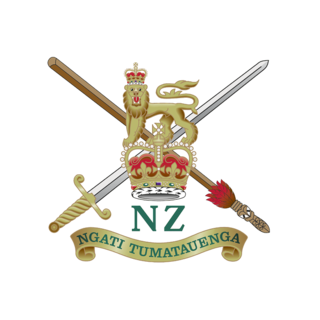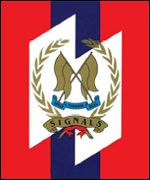Related Research Articles

The 2nd New Zealand Division, initially the New Zealand Division, was an infantry division of the New Zealand Military Forces during the Second World War. The division was commanded for most of its existence by Lieutenant-General Bernard C. Freyberg. It fought in Greece, Crete, the Western Desert and Italy. In the Western Desert Campaign, the division played a prominent role in the defeat of German and Italian forces in the Second Battle of El Alamein and the British Eighth Army's advance to Tunisia.

The New Zealand Expeditionary Force (NZEF) was the title of the military forces sent from New Zealand to fight alongside other British Empire and Dominion troops during World War I (1914–1918) and World War II (1939–1945). Ultimately, the NZEF of World War I became known as the First New Zealand Expeditionary Force. The NZEF of World War II was known as the Second New Zealand Expeditionary Force (2NZEF).

The New Zealand Army is the principal land warfare force of New Zealand, a component of the New Zealand Defence Force alongside the Royal New Zealand Navy and the Royal New Zealand Air Force.

The Royal New Zealand Infantry Regiment is the parent administrative regiment and corps of regular and reserve infantry battalions in the New Zealand Army. It was originally formed in 1947 with a singular Regular regiment and multiple reserve regiments. Over time, the regiments were turned into battalions, the reserve units amalgamated and more regular units raised and disbanded. Currently, the Regiment currently consists of two regular and three reserve battalions. Throughout its existence, units raised in this regiment have served and deployed on operations in Malaya, Vietnam, Borneo and various United Nations peacekeeping operations.

The Waikato Mounted Rifles (WMR) is the New Zealand Army's only Territorial Force squadron of the Royal New Zealand Armoured Corps (RNZAC). The Squadron's origins can be traced back to 1869 when the first mounted unit was raised in the Waikato. Today the Squadron is part of Queen Alexandra's Mounted Rifles (QAMR) where it forms the regiment's reserve squadron. WMR's role is mounted reconnaissance and surveillance.

The 3rd New Zealand Division was a division of the New Zealand Military Forces. Formed in 1942, it saw action against the Japanese in the Pacific Ocean Areas during the Second World War. The division saw action in the Solomon Islands campaign during 1943–1944, during which it undertook landings on Vella Lavella, the Treasury Islands and the Green Islands. Due to manpower shortages, for most of its existence the division consisted of only two infantry brigades in addition to support personnel, with its third brigade being disbanded shortly after formation. In 1944, manpower shortages in the New Zealand economy became acute led to the disbandment of the division. The majority of its manpower was returned to civilian employment, although around 4,000 men were sent to Italy to reinforce the 2nd Division, seeing further action before the end of the war in May 1945.

The 8th Armoured Division was an armoured division of the British Army during the Second World War. It was deployed to Egypt in June 1942 but never operated as a complete formation and was disbanded in January the following year.
Trentham Military Camp is a New Zealand Defence Force (NZDF) facility located in Trentham, Upper Hutt, near Wellington. Originally a New Zealand Army installation, it is now run by Defence and accommodates all three services. It also hosts Joint NZDF facilities including:

The 17th Division of the United States Army was formed twice during the First World War. It was then recreated a third time as a Second World War 'phantom division' as part of Fortitude South II.

Signals is the formation of the Singapore Army responsible for communications on multiple platforms and local networking on the battlefield. It also supports the Singapore Armed Forces (SAF) by developing the capacity for network-centric warfare in the form of Integrated Knowledge-based Command and Control (IKC2) and Command, Control, Communications, Computers and Intelligence (C4I) operations.

The Divisional Cavalry Regiment was an armoured cavalry regiment of the 2nd New Zealand Division during the Second World War and was New Zealand's first armoured unit. It served as a reconnaissance force for the 2nd New Zealand Division. Formed on 29 September 1939, the regiment embarked for Egypt on 4 January 1940. It fought with the division, as part of the 2nd New Zealand Expeditionary Force, in Greece, Crete, North Africa and Italy. The regiment formed part of J Force, New Zealand's contribution to the occupation of Japan at the end of the war.

The New Zealand Intelligence Corps (NZIC) analyses information from a variety of sources and provides commanders with intelligence on such things as enemy locations, capabilities and intentions. Corps personnel also provide advice on Field Security on operations.

The Beauman Division was an improvised formation of the British Expeditionary Force (BEF) during the Second World War, which fought in France against the German 4th Army in June 1940, during Fall Rot, the final German offensive of the Battle of France.
The 1st Brigade is currently the largest unit of the New Zealand Army, and contains most of the army's deployable units. The brigade was formed on 13 December 2011 by amalgamating the 2nd Land Force Group and 3rd Land Force Group. Its establishment formed part of the 'Army 2015' package of reforms.

This article describes the current structure of the New Zealand Army. It includes the army's order of battle and the headquarters locations of major units.
British Troops in Egypt was a command of the British Army.
From four Stores Depots in the main centres of New Zealand at the beginning of the 20th century, the Royal New Zealand Army Ordnance Corps (RNZAOC) expanded and shrank to meet the operational needs of the NZ Army, Ordnance units have been deployed worldwide and across the breath and width of New Zealand.

With the adoption of the Singapore strategy in the 1920s as a key cornerstone of Imperial Defence, Singapore and Malaya became the major British bases in the East, not only to defend British possessions in Asia, but also the Dominions of Australia and New Zealand, who also contributed a large portion of the construction costs.

The 9th Brigade was a formation of the New Zealand Military Forces raised for service in Italy during the Second World War. As part of the 2nd New Zealand Division, it participated in Operation Grapeshot in 1945. It then provided the basis of J Force, the New Zealand contribution to the British Commonwealth Occupation Force.
References
- Gillespie, Oliver A. (1952). Kippenberger, Howard Kard (ed.). The Pacific. The Official History of New Zealand in the Second World War 1939–1945. Wellington: Historical Publications Branch. OCLC 846901610.
- Holt, Thaddeus (2004). The Deceivers: Allied Military Deception in the Second World War. New York: Scribner. ISBN 978-0-743-25042-9.
- Stevens, William George (1958). Problems of 2 NZEF. The Official History of New Zealand in the Second World War 1939–1945. Wellington: Historical Publications Branch. OCLC 846901610.
- Thomas, Malcolm; Lord, Cliff (1995). New Zealand Army Distinguishing Patches 1911–1991: Part One. Wellington: Malcolm Thomas and Cliff Lord (self-published). ISBN 978-0-473-03288-3. OCLC 9802911903.